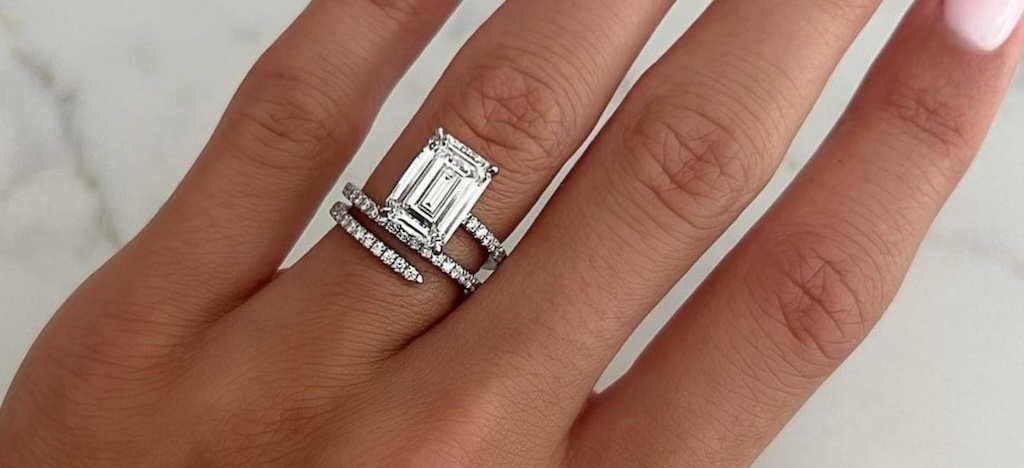An emerald cut diamond’s step-cut facets highlight clarity over sparkle, producing a more delicate and tasteful light reflection. A diamond with an emerald cut gives out a gentle glow and light flashes that resemble windows or mirrors rather than bright flashes. It is therefore perfect for people who value a chic yet subtle appearance. Let’s check out a detailed guide about emerald cut diamonds, no matter if you are looking for an emerald cut engagement ring or a wedding band.
An Emerald Cut Diamond: What is It?
A rectangular diamond with step-cut facets and bevelled corners is called an emerald cut diamond. It produces a “hall of mirrors” impression due to its long, flat facets that are placed in parallel lines, in contrast to brilliant-cut diamonds, which have triangular or kite-shaped facets for maximum brilliance. Rather than emphasizing brightness or fire, this cut highlights clarity, colour, and the inherent beauty of the stone.
Emerald cuts are big, open tables that draw attention to flaws and defects; therefore, better-grade stones are usually preferred. It is popular in both antique and modern designs because of its sleek, elongated shape, which gives it an attractive, sophisticated appearance.
Origins & History of the Emerald Cut Diamonds
The word “emerald cut” comes from the fact that it was originally meant to be used for cutting emeralds. Jewellers liked this form for emeralds because the step-cut facets reduced pressure during the cutting process, reducing the likelihood of the gem breaking or being damaged.
This cutting technique then moved to diamonds, where it was rapidly associated with sophistication and refinement. The 1920s and 1930s Art Deco period saw a sharp increase in the demand for geometric forms, symmetry, and clean lines, which is when emerald cut diamonds saw their peak in value. Emerald cut diamonds are still a classic choice today, frequently selected by people who value their blend of contemporary refinement and nostalgic charm.
Comparing Emerald-Cut Diamonds to Other Shapes
Let’s check the differences between emerald cut and other diamond shapes.
Emerald Cut vs. Radiant Cut
Stepped facets on the emerald cut give it a timeless, antique appearance. In contrast, the radiant cut appears more contemporary and bright since it combines square and rectangular aspects. Because of their intricate faceting, radiant cuts are renowned for their extraordinary brightness and brilliance. Emerald cuts have a more delicate and refined shine than radiant cuts.
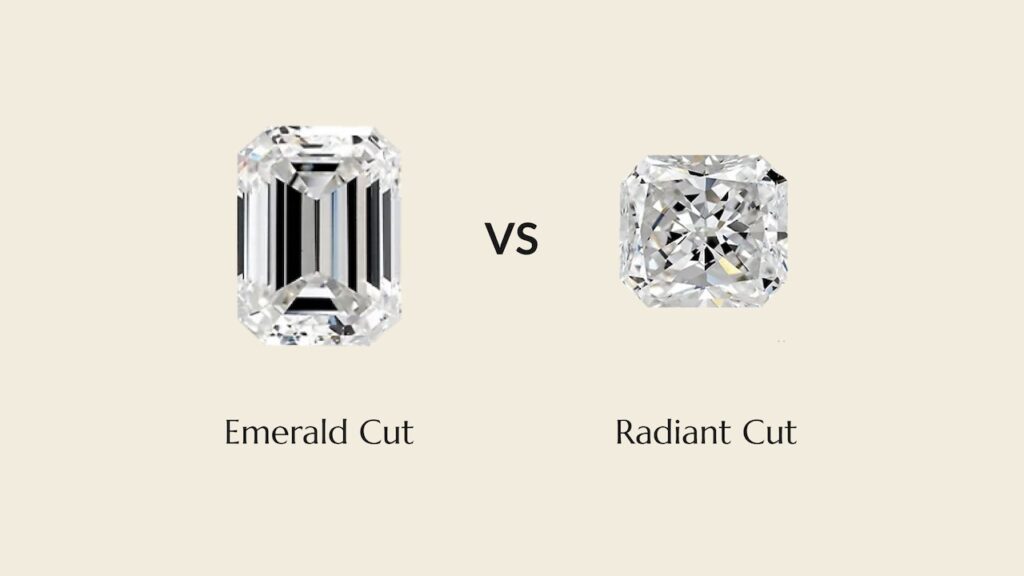
Emerald Cut vs. Asscher Cut
The asscher and emerald cuts both provide a chic, retro-inspired appearance. The form of the two cuts is the primary distinction; the asscher cut is square, while the emerald cut is rectangular. These cuts can both be quite attractive options, depending on your tastes for brilliance, form, and setting style.
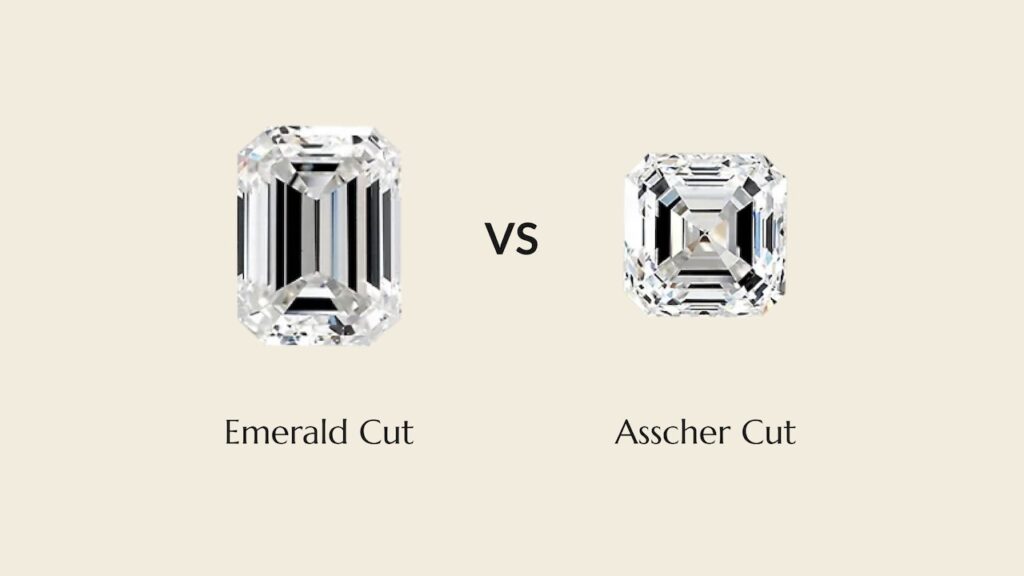
Emerald Cut vs. Cushion Cut
Emerald cut has a broad, open table and a rectangular, step-cut pattern with lengthy facets. It emphasizes clarity and produces a “hall of mirrors” image with its sleek, elegant appearance. It’s perfect for exhibiting fine gems.
Having bigger facets and rounded corners, this cushion cut is square or rectangular and has a squishy, pillow-like look. It blends fire and brightness to create a more romantic, antique vibe, and it frequently disperses light more evenly than an emerald cut.
Emerald has a sleek, elegant appeal, while cushion offers a softer, more romantic mood. Both cuts provide unique designs.
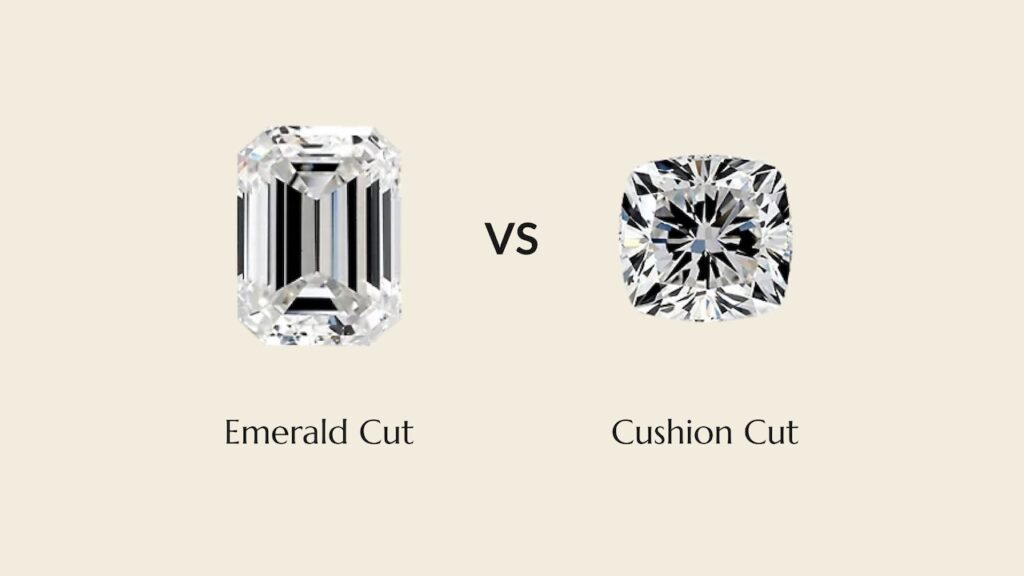
Emerald Cut vs. Round Brilliant Cut
The round brilliant cut and emerald cut have different aesthetics and appeals. The step-cut facets on the emerald cut’s smooth, rectangular form highlight the clarity and give the stone a classy, subtle appearance. It has less brightness and glitter than round diamonds of the same carat weight, but it tends to seem bigger. The round brilliant cut has 58 facets for the most sparkle and brightness. Its spherical form maximizes light reflection, producing brilliant flames. With its timeless, brilliant look, it’s quite popular and adaptable.
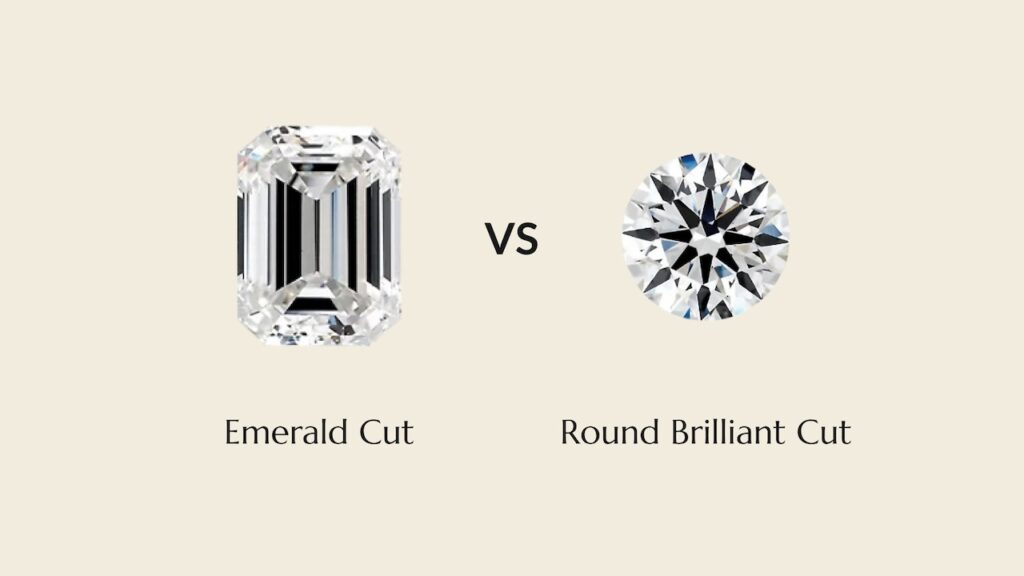
Emerald Cut vs. Princess Cut
Emerald cut has lengthy, open facets and a step-cut, rectangular shape that prioritizes clarity over brilliance. Its polished, elegant appearance brings out the colour and purity of the stone, although it has less sparkle than other cuts. For those looking for a sophisticated, stylish look, it’s ideal.
The princess cut, which is second only to the round brilliant cut in terms of brightness and fire, is square or rectangular with sharp edges. Its many facets give it a striking glitter and an angular, contemporary appearance. It is more well-liked because of its originality and modern vibe.
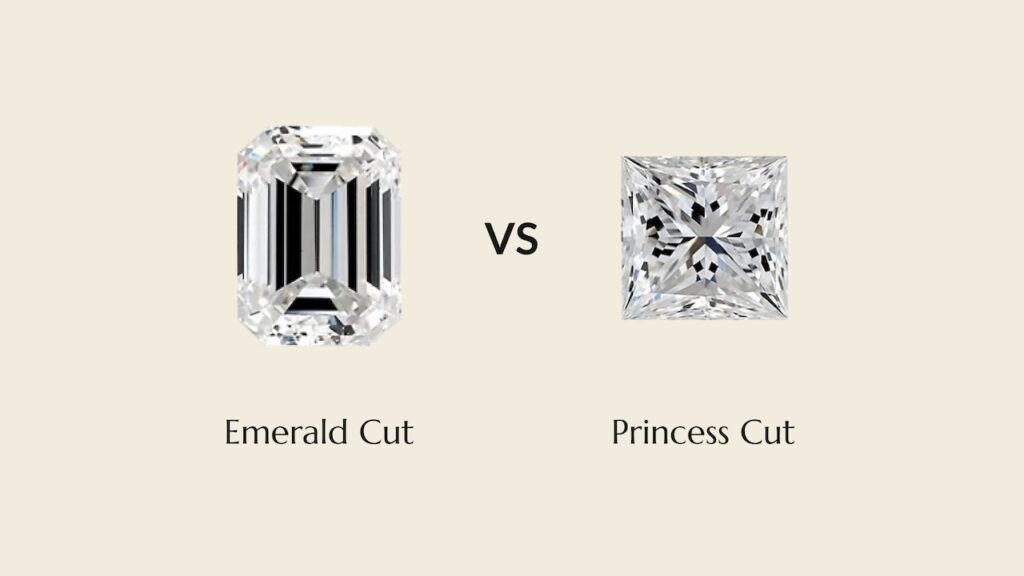
Selecting and Purchasing an Emerald Cut Stone
When selecting an emerald cut diamond, several features demand extra attention due to its distinct design. The open table and step-cut facets expose more of the diamond’s internal structure, making clarity, colour, and proportions critical factors. To fully appreciate the beauty of an emerald cut, focus on these elements:
- Colour and Clarity: Clarity and colour are crucial considerations when selecting an emerald cut diamond. Because of its step-cut facets, it is advised to have a clarity grade of VS1 or better to minimize defect visibility. Additionally, a colour grade of H or higher is recommended to avoid pronounced yellow or brown tints because the cut brings out the colour more clearly.
- Ratio and Cut Quality: The cut’s proportions also play a major role in the diamond’s overall appearance. An ideal length-to-width ratio for an emerald cut ranges from 1.30 to 1.50. A ratio closer to 1.30 creates a more square appearance, while a ratio near 1.50 offers a more rectangular, elongated look. This ensures the diamond maintains its well-balanced, elegant form.
- Warning Signs to Watch For: Here are several warning indicators or red flags to look out for when thinking about purchasing an emerald cut diamond:
- Visible Inclusions: The emerald cut tends to draw attention to any internal imperfections or inclusions because of its broad, open table and step-cut form. To avoid apparent defects in your diamond, strive for a better clarity grade.
- Colour Tint: Because the emerald cut is translucent, colour may be shown more readily than with other cuts. It is advised to use higher colour grades (near colourless or colourless) because even a small colour tint may stand out more.
- Bad Proportions: The look can be greatly impacted by improper proportions. Too shallow or too deep of a diamond can cause it to lose its brilliance and light reflection, giving it a lifeless or unappealing appearance.
- Uneven Facets: A diamond with misaligned or uneven facets may have poor symmetry and brilliance due to an altered light path.
- Lack of Sparkle: Although emerald cuts don’t have the same maximum brilliance as round or princess cuts if they seem extremely lifeless or dull, this might be a sign of shoddy craftsmanship or a low-quality stone.
When selecting this shape, careful consideration of clarity, colour, proportions, and craftsmanship is crucial since these characteristics have the potential to take away from the emerald cut’s beauty and value.
Engagement Rings with Emerald Cut Diamonds
A variety of exquisite settings for engagement rings are available with emerald cut diamonds. Here are a few well-liked looks:
- Solitaire
The emerald cut diamond’s step-cut facets and elegant lines are highlighted in a solitaire setting. The simplicity and classic style of this design are ideal for highlighting the stone’s natural beauty. For instance, an engagement ring with an emerald cut solitaire is a good choice.
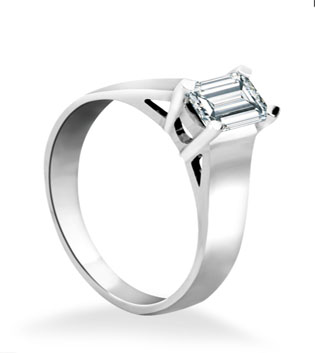
Emerald Cut Solitaire Ring with Open Gallery
- Halo
A halo setting enlarges the ring’s size and brilliance by encircling the focal stone with a ring of smaller diamonds. A striking impact may be produced by contrasting the surrounding brilliance with the polished beauty of the emerald cut.
- Triple-Tone
An emerald cut diamond usually sits as the center stone in three-stone settings, with two smaller side stones on either side. This keeps the emerald cut’s refinement while adding more sparkle.
- Pavé Ring
The ring has tiny diamonds placed into it to provide glitter and draw attention to the emerald cut center stone. Depending on the amount of diamonds on the ring, this design may be either delicate or striking.
- Bezel Setting
Featuring a contemporary and safe design, the emerald cut diamond is set inside a metal rim. The emerald cut’s geometric lines are emphasized by this design.
Sizes and Carats of Emerald Cut Diamonds
Because of their elongated shape, emerald cut diamonds seem bigger than other cuts of the same carat weight and they are available in a variety of sizes and carat weights. Here is a brief guide:
- Carat Weight and Sizes: Emerald cuts appear bigger than round diamonds of the same carat weight because of their elongated, rectangular form. This impact is amplified by the emerald’s table’s vast surface area.
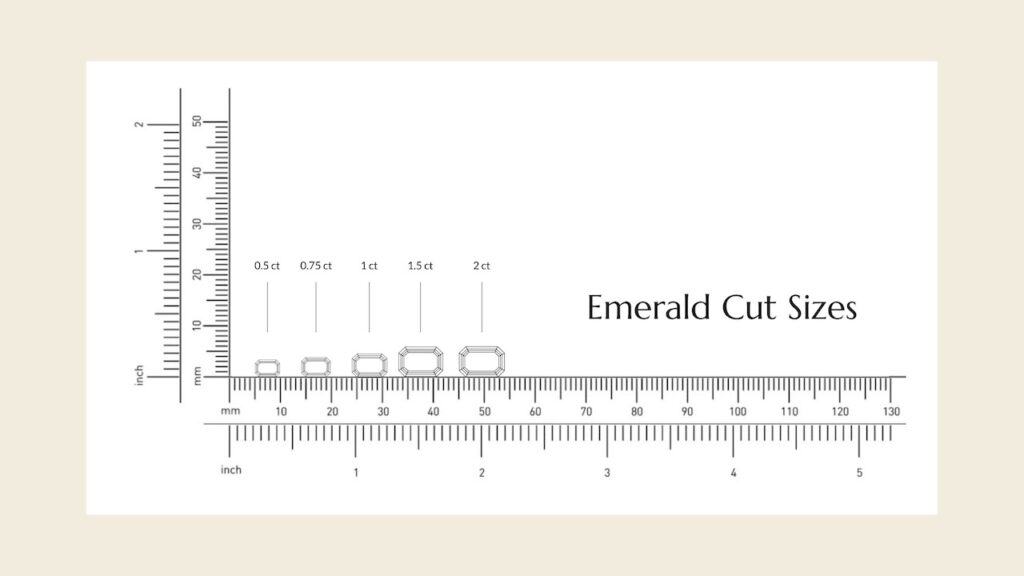
- Depth and Table: Since they have an impact on the diamond’s look and light performance, aim for a depth percentage of 60–70% and a table percentage of 60–65% for the ideal proportions.
- Length-to-Width Ratio: As mentioned earlier, the optimal ratio for an emerald cut lies between 1.30 and 1.50, offering the ideal rectangular shape. A ratio closer to 1.30 results in a more compact, squarish appearance, while moving toward 1.50 creates a longer, more elongated look. Though personal preference plays a role, these proportions ensure a well-balanced and elegant design.
- The emerald cut diamond will appear gorgeous and be proportionate to the ring design if the carat weight, size, and proportions are well balanced.
Wedding and Eternity Bands with Emerald Cuts
Wedding and eternity rings can also have diamonds with emerald cuts. A row of tiny emerald cut diamonds set in a continuous pattern may be included in these bands. For a coordinated combination, these bands are frequently worn with emerald cut engagement rings.
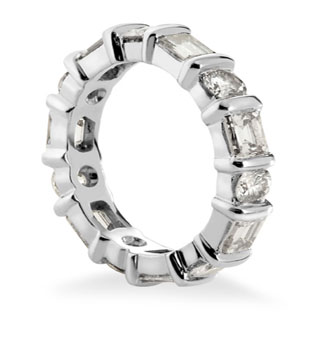
Emerald & Brilliant Cut Diamond Ring
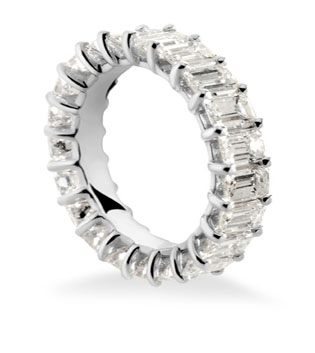
Emerald Cut Diamond Ring in Shared Claw
Pros and Cons of Emerald Diamonds
| Pros | Cons |
|---|---|
| Because of its extended form seems larger | Does not radiate as brightly as other cuts |
| Premium diamonds with little imperfections | Flaws are easier to see due to fewer facets |
| Less common shape makes them stand out | Corners can chip easily without proper care |
For individuals who want a style that is influenced by the past and exudes sophistication and elegance, the emerald cut diamond is the ideal option. The adaptability of the emerald cut makes it appropriate for a variety of settings and styles, whether you’re selecting an engagement ring or a matching wedding band.
To optimize the attractiveness of an emerald cut diamond, always pick a cut with perfect proportions. Keep in mind that clarity and colour are particularly significant factors. An emerald cut diamond may become an everlasting representation of your love and dedication with the appropriate setting.

